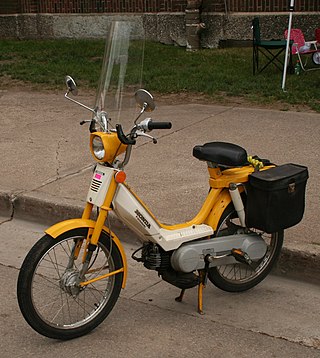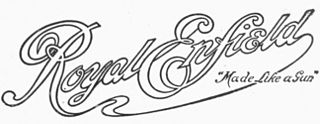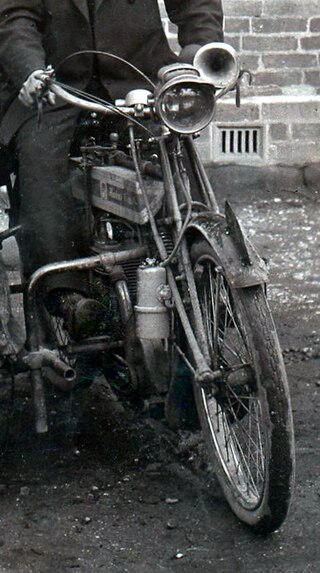
A moped is a type of small motorcycle, generally having a less stringent licensing requirement than full motorcycles or automobiles. Historically, the term exclusively meant a similar vehicle with both bicycle pedals and a motorcycle engine. Mopeds typically travel only a bit faster than bicycles on public roads.
Triumph Engineering Co Ltd was a British motorcycle manufacturing company, based originally in Coventry and then in Meriden. A new company, Triumph Motorcycles Ltd, based in Hinckley, gained the name rights after the end of the company in the 1980s and is now one of the world's major motorcycle manufacturers.

Royal Enfield was a brand name under which The Enfield Cycle Company Limited of Redditch, Worcestershire sold motorcycles, bicycles, lawnmowers and stationary engines which they had manufactured. Enfield Cycle Company also used the brand name "Enfield" without the "Royal".

Malaguti is an Italian bicycle, scooter and motorcycle company based in San Lazzaro di Savena, founded by Antonino Malaguti in 1930. Producing bicycles until 1958, they then entered the motorcycle market. Noted for their use of small engines in their bikes. In October 2011, Malaguti laid off its remaining employees in Bologna, Italy as the company eventually folded.

A motorized bicycle is a bicycle with an attached motor or engine and transmission used either to power the vehicle unassisted, or to assist with pedalling. Since it sometimes retains both pedals and a discrete connected drive for rider-powered propulsion, the motorized bicycle is in technical terms a true bicycle, albeit a power-assisted one. Typically they are incapable of speeds above 52 km/h (32 mph).

A.H. Haden Motorcycles was a British motorcycle marque from Birmingham.
This timeline of motorized bicycle history is a summary of the major events in the development and use of motorized bicycles and tricycles, which are defined as pedal cycles with motor assistance but which can be powered by pedals alone.
Norman Cycles was a British bicycle, autocycle, moped, and motorcycle manufacturer in Ashford, Kent, England.

The James Cycle Co Ltd., Greet, Birmingham, England, was one of many British cycle and motorcycle makers based in the English Midlands, particularly Birmingham. Most of their light motorcycles, often with the characteristic maroon finish, used Villiers and, later, AMC two-stroke engines.

Villiers Engineering was a manufacturer of motorcycles and cycle parts, and an engineering company based in Villiers Street, Wolverhampton, England.

The Cotton Motor Company, was a British motorcycle manufacturer of 11a Bristol Road, Gloucester, and was founded by Frank Willoughby Cotton in 1918. F.W. presided over the company until his retirement in 1953. The company was reconstituted as E. Cotton (Motorcycles) Ltd, and traded until 1980. The marque was later resurrected in the late 1990s by a business which manufactured replicas of earlier machines.

Sparta B.V. is a Dutch bicycle manufacturer based in Apeldoorn that also produced motorcycles and Mopeds. It is the largest electrical bike manufacturer in Europe.

Rieju is a Spanish manufacturer of mopeds and motorcycles from Spain. It is based in Figueres. They specialise in small-displacement motorcycles using Minarelli engines. Their products are available in almost all European countries.

Coventry-Eagle was a British bicycle and motorcycle manufacturer. Established as a Victorian bicycle maker, the company began under the name of Hotchkiss, Mayo & Meek. The company name was changed to Coventry Eagle in 1897 when John Meek left the company. By 1898 they had begun to experiment with motorised vehicles and by 1899, had produced their first motorcycle. The motorcycles were hand built from components and finished carefully, Coventry-Eagle motorcycles proved reliable and by the First World War the range included Villiers Engineering and JAP engines.
Dunelt Motorcycles was a British motorcycle and bicycle manufacturer. Based in Sheffield, the business was founded by two steel makers and engineers, Dunford and Elliott of Sheffield in 1919. Their first motorcycle was an innovative supercharged 499 cc two-stroke single. The company specialised in good quality sidecars from 1926 and a Dunelt motorcycle was first to cross the desert from Cairo to Siwa and back in 1924. Dunelt also enjoyed racing success and won the Double Twelve Hour World Record at Brooklands with a Model K in 1928. Dunelt moved into commercial three-wheeled cars but these were not a success. A Dunelt moped was exhibited at the Earls Court show in 1956 but the company diversified into other areas of engineering in 1957.
New Hudson Motorcycles was a British motorcycle manufacturer. Founded in 1903 by George Patterson in Birmingham, their first motorcycle was produced in 1902 but was unsuccessful. The New Hudson range expanded between 1910 and 1915 using JAP engines, then the factory joined the war effort until 1919. As well as side-valve and OHV single-cylinder engines of 350 to 600 cc, they also built a 211 cc two-stroke and a number of three-wheelers with MAG engines. In 1927 Bert le Vack broke the 100 miles per hour (160 km/h) record at Brooklands on a 500 cc New Hudson.

Bradbury Motor Cycles was a British motorcycle manufacturer based in Oldham, England and established in 1902. Originally involved in the manufacture of machine tools, sewing machines and cycles, their first motorcycles were bicycles with clip-on Minerva engines. The Bradbury factory went on to develop and produce a range of single-cylinder motorcycle, V-twins and horizontally opposed twins. The 1912 Bradbury motorcycles were one of the earliest with variable gearing. Although the factory survived the First World War it closed in 1924.

The Ruby Cycle Co Ltd. was a British motorcycle manufacturer based in Ancoats Manchester. Founded in 1909 the factory produced a range of motorcycles under the Royal Ruby brand until 1932.

BSA motorcycles were made by the Birmingham Small Arms Company Limited (BSA), which was a major British industrial combine, a group of businesses manufacturing military and sporting firearms; bicycles; motorcycles; cars; buses and bodies; steel; iron castings; hand, power, and machine tools; coal cleaning and handling plants; sintered metals; and hard chrome process.

The Bown Manufacturing Company was established in 1862 in Birmingham by local machinist, William Bown, making a variety of patented mechanical parts. The name Aeolus had been used as a trademark since 1877 and especially for cycle parts. A second-cousin took over the company when the founder died in 1900 and began making powered-cycles also under the Aeolus brand. Production was interrupted by the First World War, after which motorcycles were marketed under the Bown brand until 1924. The company was subsequently acquired by the Aberdale Cycle Company in the 1930s.















